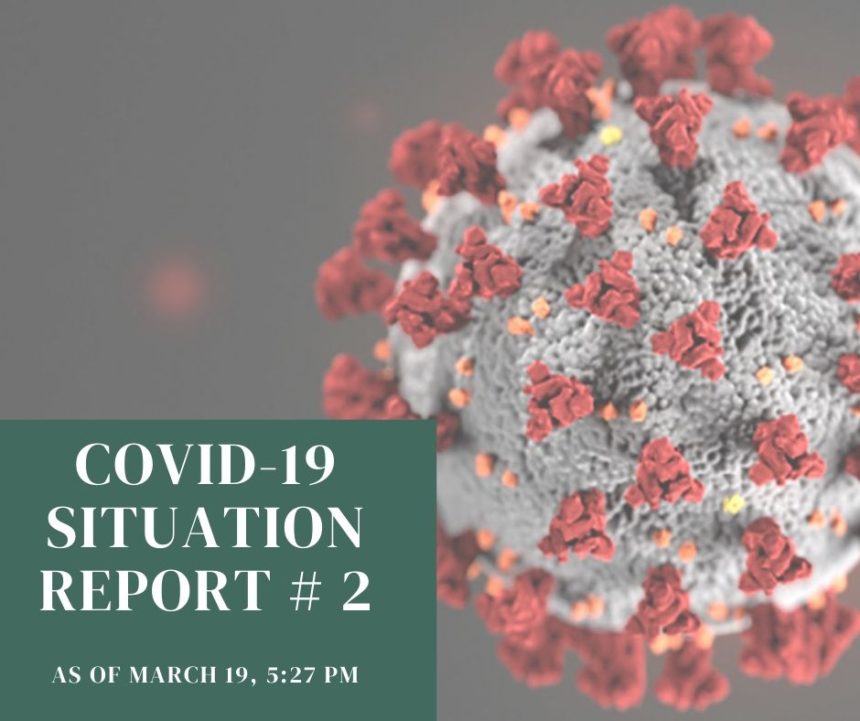| Overall Situation | ||||||||||||||||||
| · On March 7, the Department of Health raised the COVID-19 Alert System Code to Code Red Sublevel 1.
· On March 8, with the recommendation of the DOH, the Office of the President declared a State of Public Health Emergency. · On March 12, a Presidential Press Conference was conducted announcing the raising of the Philippines’ COVID-19 Alert Level System to Code Red Sublevel 2. · On March 16, a Memorandum from the Executive Secretary was issued regarding Community Quarantine Over the Entire Luzon and Further Guidelines for the Management of the COVID-19 Situation. · On March 16, the entire Philippines was placed under a State of Calamity. |
||||||||||||||||||
| Reports on Affected Populations | ||||||||||||||||||
| · As of March 19, 338 Patients Under Investigation (from the previous 259) are currently admitted in different facilities in Regions I, II, III, CALABARZON, VI, VII, VIII, X, XI, XII, CARAGA, CAR, and NCR.
· A total of 217 cases (from the previous 202) were confirmed in Regions I,II, III, CALABARZON, VI, VII, X, XI, CARAGA, CAR, and NCR. Of which, 17 were reported dead and 8 (from the previous 7) have recovered. · A total of 1,047 cities/municipalities (from the previous 1,016) in all regions declared suspension of classes. · On March 17, a work from home arrangement was implemented in the government’s Executive branch, except PNP, AFP, PCG, and health and emergency frontline services, border control and other critical services, which shall ensure a skeletal work force. · Work in all government offices in the provinces and Ilocos Norte and La Union were declared suspended on March 14 and March 16, respectively. · Work suspension at the Provincial Government of Occidental Mindoro and Oriental Mindoro were declared on March 17. · Work of Municipal Government of Pinamalayan, Oriental Mindoro was suspended on March 17 except the frontline offices. · Land, domestic air, and domestic sea travel to and from Metro Manila is suspended from March 15 to April 14 as declared by President Rodrigo Duterte during the Presidential Press Conference on March 12. · The following areas were also declared under State of Calamity prior the declaration of the National State of Calamity:
(Source: NDRRMC)
· Shortage of medical masks was reported in various parts of the country due to concerns over the pandemic. · 14.4 million non-regular workers and informal earners, or 3 out of 5 employed person in Luzon, are most at risk of lost wager and earnings due to the Luzon-wide lockdown. Many low-income Filipinos in poor-quality jobs or precarious work – or work that is insecure, low-paying, and lack benefits – face lost wages and earnings during the lockdown. · There are already reports of workers faced with reduced work hours or forced leave due to limited operations of business establishments. Others, like small business owners and theor employees have had significant loss of earnings due to the drop in customer traffic. · Of the P27.1 billion spending plan for COVID-19 rolled out by the government, on P2 billion has been allotted as wage subsidy or financial support for displaced workers and P1.2 billion for social security unemployment benefits. Non-regular workers may not be able to avail of this cash assistance because of their irregular or informal status. (Source: IBON Foundation) · On March 16, the Department of Foreign Affairs announced that the Philippines will stop issuing visas to foreigners worldwide to prevent the further spread of COVID-19 in the country. · Since March 16, Bulacan farmers reported that their vegetable produce were blocked from entering Quezon City markets. Trucks carrying sacks of rice from Batangas were also blocked. Fisherfolk organizations also reported that some Cavite and Central Luzon fish suppliers and vendors were barred from entering Metro Manila. Due to the long queue of vehicles at checkpoint areas, many food and supply deliveries were also delayed. (Source: Kilusang Magbubukid ng Pilipinas) · On March 18, some markets in NCR reportedly closed because of the impeded movement of food from the provinces. These are Novaliches market in Quezon City; San Juan market and Dagohoy market in Manila. |
||||||||||||||||||
| Emergency Response Efforts | ||||||||||||||||||
| · On March 12 and 13, CDRC conducted staff meeting to discuss initial response plans.
· On March 16, employees were advised to work from home. · Efforts to raise funds are ongoing. |
||||||||||||||||||
| Resources Available | ||||||||||||||||||
| · Standby emergency funds
· Prepositioned goods at the CDRC warehouse |
||||||||||||||||||
| Expressed Needs | ||||||||||||||||||
| · Immediate needs of the affected population include face masks, hygiene kits, food packs and cash assistance for poor families who do not have income because of the quarantine. | ||||||||||||||||||
| Coordination | ||||||||||||||||||
| · Citizens’ Disaster Response Network | ||||||||||||||||||
| Contacts | ||||||||||||||||||
| · Kim Augiline Leduna, Executive Director, (insert cellphone number), info@cdrc-phil.com
· Malen Serato, Field Operations Department, 0916-499-1410, fod@cdrc-phil.com · Hanna Fiel, Research and Public Information Department, 0945-8355589, hanna.fiel.cdrc2019@gmail.com · Cora Jazmines, Local Partnerships Department, 0949-845-1271, lpd@cdrc-phil.com |
||||||||||||||||||
COVID 19 Situation Report #2 March 19, 2020 5:27 pm

